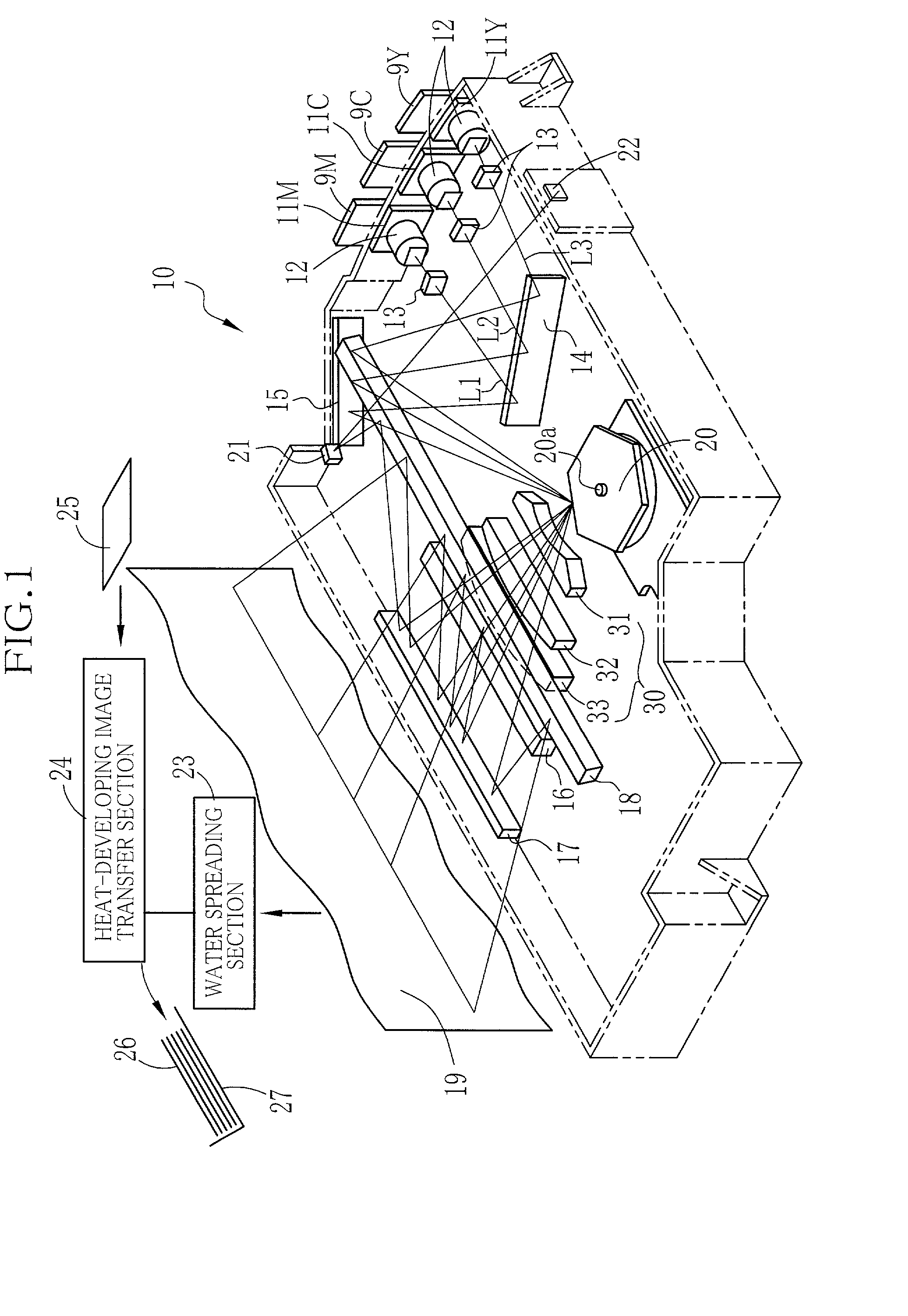F-theta lens, beam scanning device, and imaging apparatus
a beam scanning and f-theta technology, applied in the direction of lenses, instruments, optical elements, etc., can solve the problems of wasting material, requiring labor-intensive cutting of spherical lenses into strips, and high material cos
- Summary
- Abstract
- Description
- Claims
- Application Information
AI Technical Summary
Benefits of technology
Problems solved by technology
Method used
Image
Examples
first embodiment
[0077] It is also possible to cement the first and second lens elements 31 and 32 to each other as a doublet, as shown in FIG. 2D. This configuration provides the same effect as the first embodiment shown in FIG. 2B, and also reduces the risk of deviation of the lens elements from their proper positions. Such a deviation would damage the lens performance.
example 1
[0078] In Example 1, the frequencies fm, fc and fy of the clock pulses generated from the oscillators 51M, 51C and 51Y are respectively determined as follows:
[0079] fm:fc:fy=1 / 1.000459:1:1 / 0.999620
[0080] The f-.theta. lens 30 is composed of first to third lens elements having the same configuration as the embodiment shown in FIG. 2A, and the first and second lens elements 31 and 32 are cemented to each other to form a doublet, as shown in FIG. 2D.
[0081] Numerical values for Example 1 are as set forth below.
[0082] .vertline.f.vertline.=373.324 mm
[0083] .vertline.f1.vertline.=153.955 mm
[0084] .vertline.f23.vertline.=98.170 mm
[0085] .theta.=50.degree.
[0086] wherein f represents the total focal length of the f-.theta. lens 30, f1 represents the focal length of the first lens element 31, f23 represents a composite focal length of the second and third lens elements, .theta. represents the deflection angle of the light beams by the polygonal mirror 20.
[0087] Table 1 shows lens data of Exam...
example 2
[0092] In the Example 2, the frequencies fm, fc and fy of the clock pulses generated from the oscillators 51M, 51C and 51Y are respectively determined as follows:
[0093] fm:fc:fy=1 / 1.000582:1:1 / 0.999532
[0094] The f-.theta. lens 30 is composed of first to third lens elements having the same configuration as the embodiment shown in FIG. 2A, and the first to third lens elements 31 to 33 are arranged separately from each other in a manner as shown in FIG. 2B.
[0095] Numerical values for Example 2 are as set forth below, and Table 2 shows lens data of Example 2.
[0096] .vertline.f.vertline.=276.541 mm
[0097] .vertline.f1.vertline.=112.901 mm
[0098] .vertline.f23.vertline.=93.597 mm
[0099] .theta.=67.degree.
2TABLE 2 i R D N .nu. DEFLECTION 16.0 POINT 1 -80.600 5.9 1.72825 28.32 2 .infin. 4.1 3 .infin. 10.0 1.51680 64.20 4 -77.750 4.5 5 .infin. 10.5 1.51680 64.20 6 -115.400 326.057 IMAGE PLANE
[0100] As shown in Table 2, the refractive indexes N1, N2 and N3 of the first to third lens elements 31 ...
PUM
 Login to View More
Login to View More Abstract
Description
Claims
Application Information
 Login to View More
Login to View More - R&D
- Intellectual Property
- Life Sciences
- Materials
- Tech Scout
- Unparalleled Data Quality
- Higher Quality Content
- 60% Fewer Hallucinations
Browse by: Latest US Patents, China's latest patents, Technical Efficacy Thesaurus, Application Domain, Technology Topic, Popular Technical Reports.
© 2025 PatSnap. All rights reserved.Legal|Privacy policy|Modern Slavery Act Transparency Statement|Sitemap|About US| Contact US: help@patsnap.com



